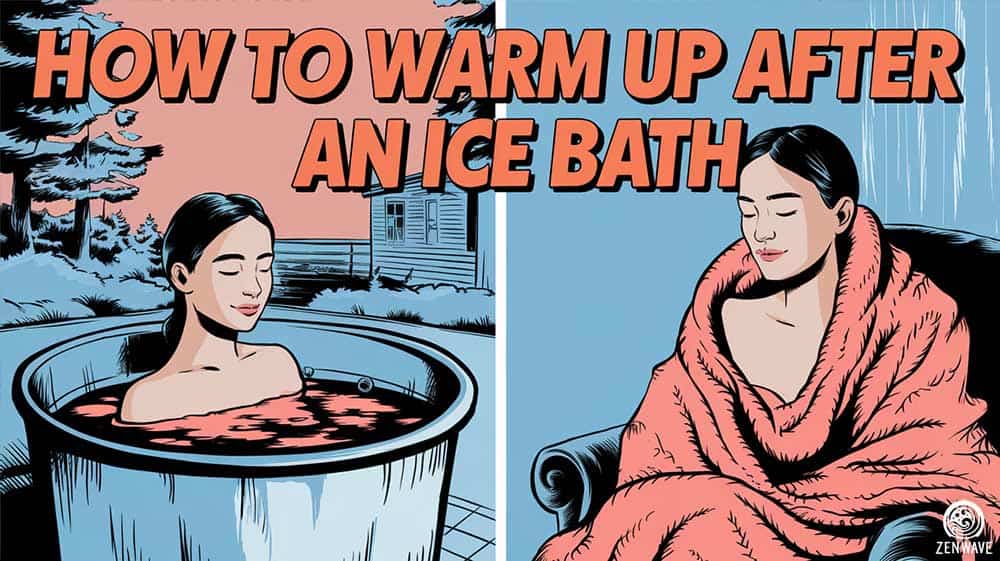Ice baths have gained popularity for their potential health benefits, but the post-bath routine is just as crucial as the cold plunge itself. Proper care after an ice bath can maximize its advantages while minimizing risks.
This guide will walk you through the essential steps to take after your ice bath, common mistakes to avoid, and important considerations like understanding “after drop.”
From shivering novices to frost-embracing veterans, this guide will be your thermal compass, steering you through the crucial moments when your body transitions from icy shock to warm recovery.
No fluff, no filler – just cold, hard facts to revolutionize your ice bath routine.
Warming Up After an Ice Bath: A Step-by-Step Guide
1. Exit the ice bath slowly
Carefully stand up and step out of the bath, using support if needed. Cold exposure can affect your balance and coordination. Move slowly to prevent dizziness or sudden blood pressure changes that could lead to fainting.
Be mindful of hydrostatic compression effects. When submerged, water pressure causes your heart to relax slightly. Upon exiting, this pressure suddenly falls away, which can cause lightheadedness as your heart adjusts to pump blood efficiently to your head again.
2. Dry off thoroughly
Immediately use a towel to remove excess water from your body, especially your extremities. Water droplets on your skin cause evaporative cooling, which can rapidly lower your body temperature. Thorough drying prevents further heat loss and reduces the risk of hypothermia.
However, if you’re in a warm environment (like after a cold shower in a heated bathroom) and not at risk of hypothermia, you might choose to skip thorough drying. Allowing some dampness on your skin can promote shivering, which increases metabolic rate and activates brown fat.
3. Allow natural warm-up
Resist the urge to seek immediate heat sources. Let your body warm up naturally through a process called thermogenesis. This maximizes the benefits of the ice bath by promoting better blood circulation and helping your body adapt to temperature changes more effectively.
Natural rewarming encourages your body to activate brown fat, which generates heat and can have metabolic benefits. Rushing to external heat sources like saunas can negate some of these adaptations.
4. Perform light exercises
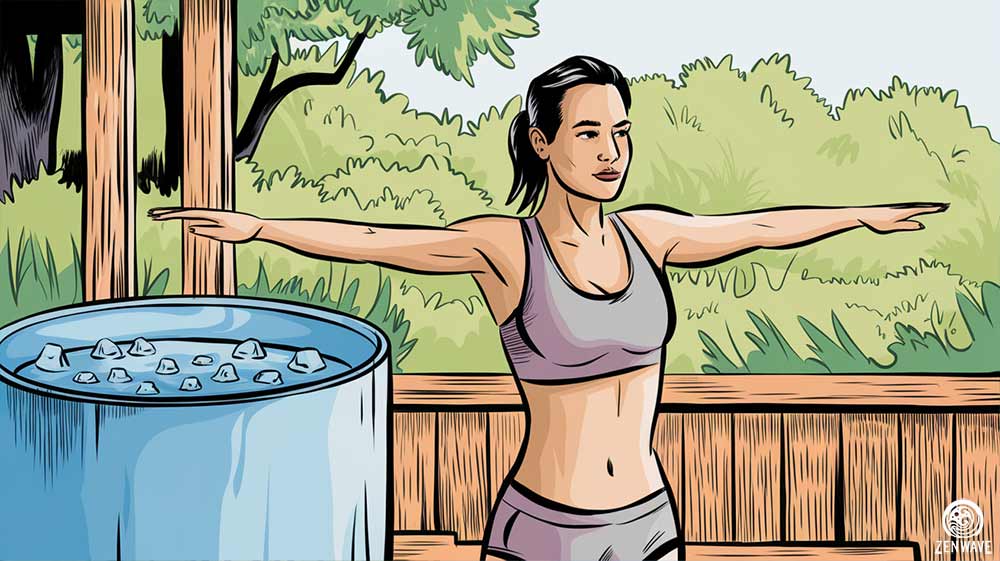
Engage in gentle movements like walking, arm circles, or the Horse Stance exercise. Light activity increases blood flow and raises your body temperature gradually without overexerting cold muscles. Aim for 3-5 minutes of gentle movement to stimulate circulation.
The Horse Stance, popular in the Wim Hof Method, can be particularly effective. It allows you to focus on rhythmic movements instead of your cold body, aiding in both physical and mental recovery.
5. Hydrate with warm beverages
Drink warm (not hot) liquids such as herbal tea or lukewarm water. This helps raise your core body temperature from the inside and aids in rehydration. Avoid very hot drinks as they can cause a sudden temperature shock to your system.
Consider including drinks with some carbohydrates, as your body uses glucose faster during cold exposure. This can help fuel your body’s warming efforts.
6. Dress in warm, dry clothing
Put on layers of warm, dry clothing to aid in gradual temperature increase. Choose breathable fabrics that won’t trap moisture against your skin. This step helps prevent chills and supports your body’s natural warming process.
The level of clothing needed depends on your environment and how cold you feel. In warm weather, minimal clothing might suffice, while colder conditions require more insulation.
7. Monitor your body’s response
Pay attention to how you feel during the warm-up process. If you’re not warming up naturally within 30 minutes, consider adding more clothing layers or taking a warm shower. This self-awareness ensures your safety and helps you understand your body’s limits.
Be alert for signs of “after drop,” a phenomenon where your core temperature continues to fall after exiting the cold. Symptoms include severe shivering 10-15 minutes post-exposure. If this occurs, seek warmth more actively.
8. Consider carbohydrate intake
Consume some fast-acting carbohydrates, like a banana or a sugary drink, shortly after your cold session. Cold exposure depletes glucose stores more quickly, and replenishing them can help fuel your body’s warming efforts.
Carbohydrates are particularly effective for fueling shivering, which is your body’s natural warming mechanism.
9. Gradually return to normal activities
Once you’ve warmed up, you can slowly return to your regular routine. Avoid intense activities for at least an hour after your ice bath to allow your body to fully recover and reduce the risk of injury. Also consider throwing in some ice bath breathing techniques to add a little more Zen to your post cold therapy session.
If you plan to use contrast therapy (alternating hot and cold exposure), it’s generally recommended to start with heat, end with cold, and then allow natural rewarming for maximum metabolic benefits.
What Not to Do: Common Mistakes to Avoid After an Ice Bath
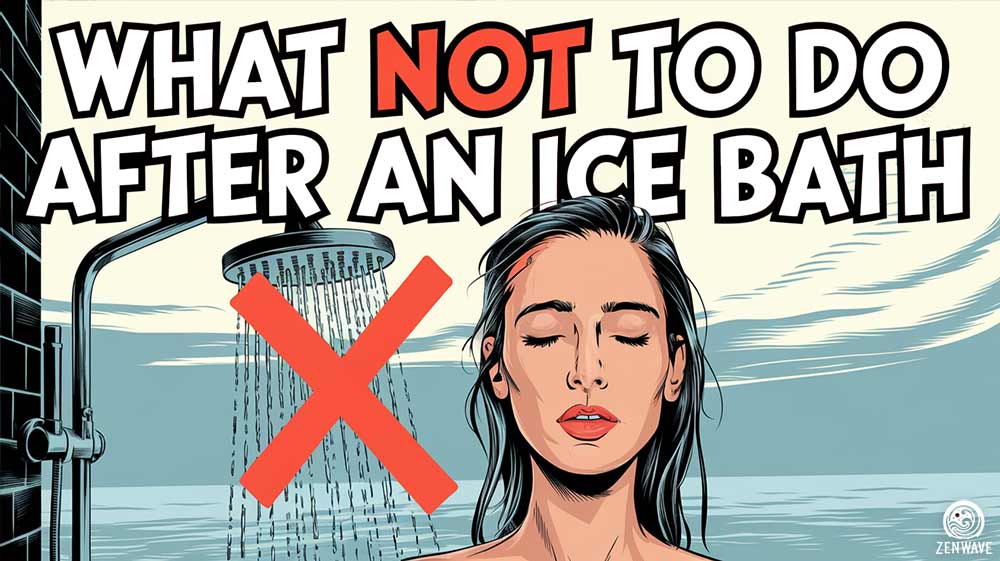
1. Don’t take a hot shower immediately
Resist the urge to jump into a hot shower right after your ice bath. Rapid temperature changes can cause sudden vasodilation (widening of blood vessels), potentially leading to dizziness or fainting. Moreover, it can trigger an “after drop” in core body temperature, where cold blood from your extremities rushes back to your core, causing a dangerous temperature plunge.
Wait at least 30 minutes before showering, and when you do, start with lukewarm water and gradually increase the temperature if needed.
2. Avoid intense exercise right away
While light movement is beneficial, intense exercise immediately after an ice bath can be counterproductive and potentially dangerous. Your muscles are cold and less pliable, increasing the risk of strains or other injuries. Additionally, vigorous activity can divert blood flow away from your core, potentially prolonging the rewarming process.
Stick to gentle movements for at least an hour post-bath before considering any strenuous activities.
3. Don’t use heating pads on high settings
After exposure to cold, your skin’s sensitivity may be reduced, increasing the risk of burns from heating pads or other direct heat sources. If you choose to use a heating pad, always use it on a low setting and avoid direct contact with your skin.
Instead of heating pads, consider warm (not hot) compresses or simply bundling up in layers of clothing to warm gradually.
4. Avoid alcohol
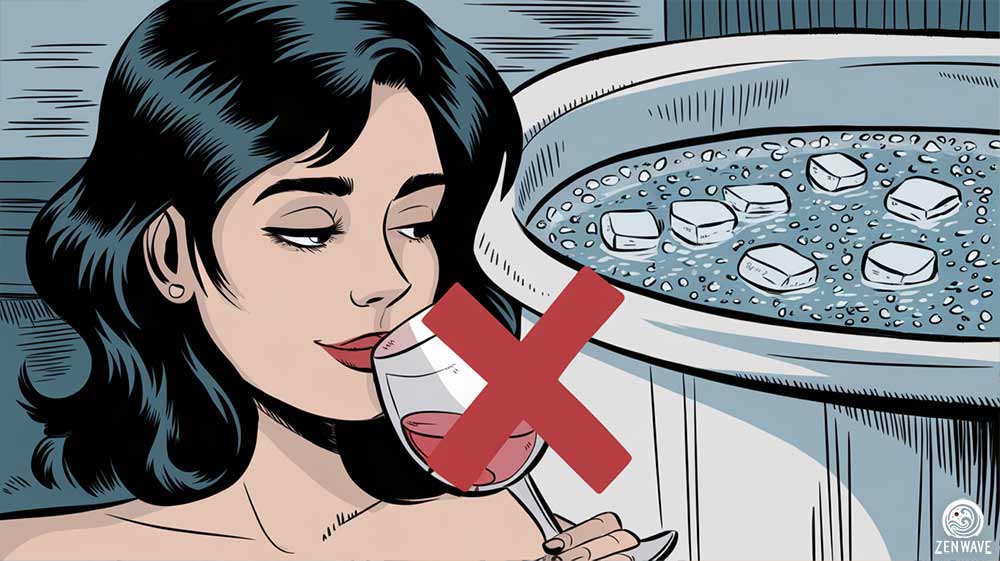
While a “warming” alcoholic drink might seem appealing, alcohol can impair your body’s ability to regulate temperature effectively. It dilates blood vessels near the skin, which can make you feel warmer but actually accelerates heat loss. Moreover, alcohol can impair your judgment, potentially leading to unsafe decisions during the rewarming process.
Stick to warm, non-alcoholic beverages that hydrate and nourish your body.
5. Don’t rush the warming process
Patience is crucial when rewarming after an ice bath. Rushing to warm up quickly by using saunas, hot tubs, or other intense heat sources can shock your system and negate many of the benefits of cold exposure. Rapid rewarming can also lead to the “after drop” phenomenon mentioned earlier.
Allow your body to warm up gradually and naturally. This process encourages beneficial adaptations like increased brown fat activation and improved temperature regulation.
6. Don’t skip the warm-up routine
It might be tempting to quickly dry off and get on with your day, especially if you’re short on time. However, skipping proper post-ice bath care can negate the benefits of the practice and potentially put you at risk.
Always allocate enough time for a proper warm-up routine after your ice bath.
7. Avoid immediate exposure to very cold environments
If you’ve taken your ice bath outdoors in cold weather, don’t linger in the cold environment afterward. Your body temperature is already lowered, and continued exposure to cold can make it difficult for your body to warm up effectively.
Move to a warmer environment as soon as possible after your ice bath.
8. Don’t combine with other intense therapies without guidance
Avoid combining ice baths with other intense therapies like prolonged fasting or extreme heat exposure without proper guidance, preparation, or supervision. While these practices can have benefits individually and combined, doing them improperly can stress your body excessively.
Understanding “After Drop”
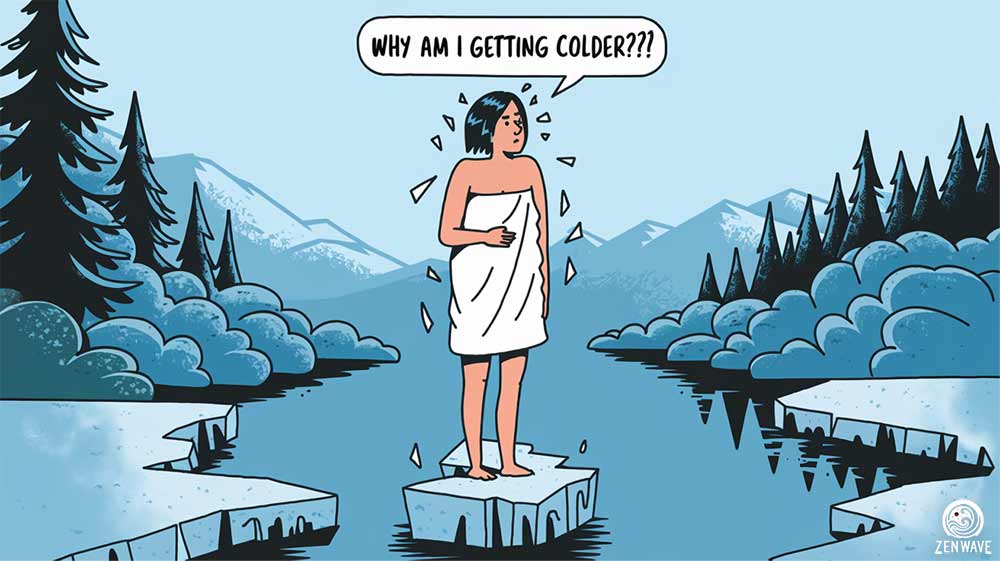
“After drop” is a potentially dangerous phenomenon that can occur after exposure to cold water, such as during an ice bath. It refers to a continued decrease in core body temperature even after the person has exited the cold environment. This unexpected temperature decline can pose serious health risks if not properly understood and managed.
Recognizing the signs of after drop is crucial for safety. Common symptoms include:
- Intense shivering, typically 10-15 minutes post-exposure
- Sudden feeling of cold, despite being out of the ice bath
- Dizziness or lightheadedness
- Confusion or disorientation
- Weakness or fatigue
- In severe cases, loss of coordination or consciousness
To minimize the risk of after drop, it’s important to follow proper protocols above when exiting an ice bath. Limit cold exposure time based on water temperature and personal tolerance. Exit the ice bath slowly to allow gradual blood flow changes. Dry off thoroughly and immediately after exiting. Warm up naturally and gradually, avoiding sudden heat exposure. Perform gentle exercises to encourage circulation, and dress in warm, dry layers to insulate the body.
Managing After Drop
If you suspect you’re experiencing after drop, take immediate action. Move to a warm, dry environment right away. Remove any wet clothing and wrap yourself in warm, dry blankets. Drink warm (not hot) fluids to help raise core temperature. Perform gentle movements to generate internal heat. If symptoms are severe or persist, don’t hesitate to seek medical attention.
Remember, while after drop is a risk associated with cold water immersion, proper techniques and awareness can significantly reduce this risk.
Sauna and Ice Baths: Contrast Therapy
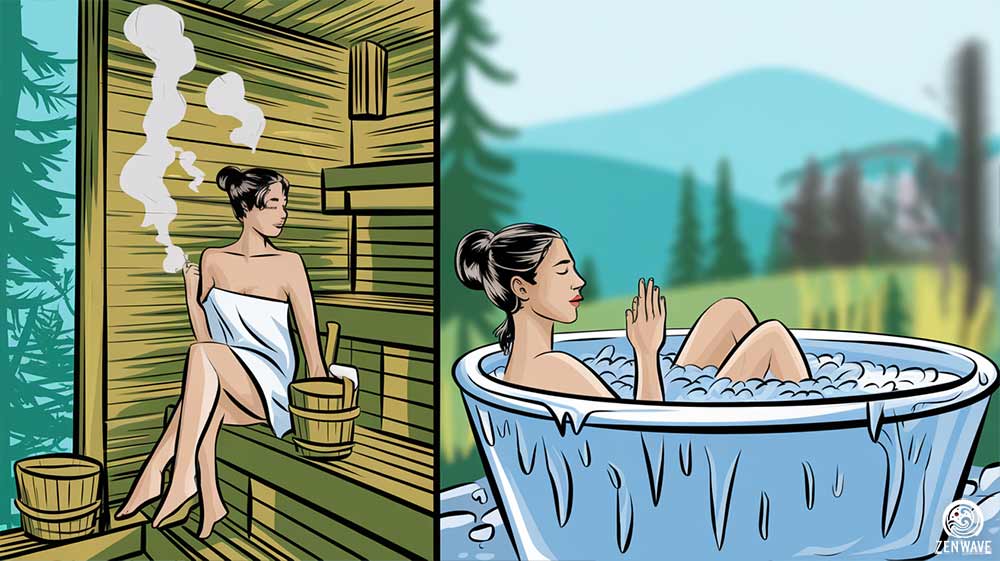
Contrast therapy, combining sauna use with ice baths, can enhance the benefits of each when done correctly. The recommended approach is to start with heat exposure (sauna) followed by cold immersion (ice bath).
This sequence offers several advantages:
- Sauna use prepares the body by increasing blood flow and relaxing muscles.
- Transitioning from hot to cold enhances circulation and provides a beneficial physiological “shock.”
- This order is safer for the cardiovascular system.
- It allows for initial detoxification through sweating before cold exposure.
- Most find it more comfortable and sustainable.
A typical protocol might be:
- 15-20 minutes in the sauna
- 1-3 minutes in the ice bath
- Repeat 2-5 times
However, contrast therapy isn’t suitable for everyone. Those with health conditions should consult a professional before starting. Begin slowly, gradually building tolerance to both heat and cold. With proper implementation, contrast therapy can be a powerful addition to your wellness routine.
Final Thoughts
The moments after you step out of that icy water are critical. They can make the difference between reaping the full benefits of your cold plunge and potentially putting your body at risk.
Remember: patience is key. Your body needs time to adapt and warm up naturally. Resist the urge to shock your system with immediate heat or intense activity. Instead, focus on gradual rewarming, gentle movement, and staying attuned to your body’s signals.
Mastering the post-ice bath routine isn’t just about comfort – it’s about maximizing the physiological benefits while minimizing risks. With practice, you’ll develop a personalized routine that works best for you. Stay safe, listen to your body, and enjoy the invigorating journey of cold therapy.

